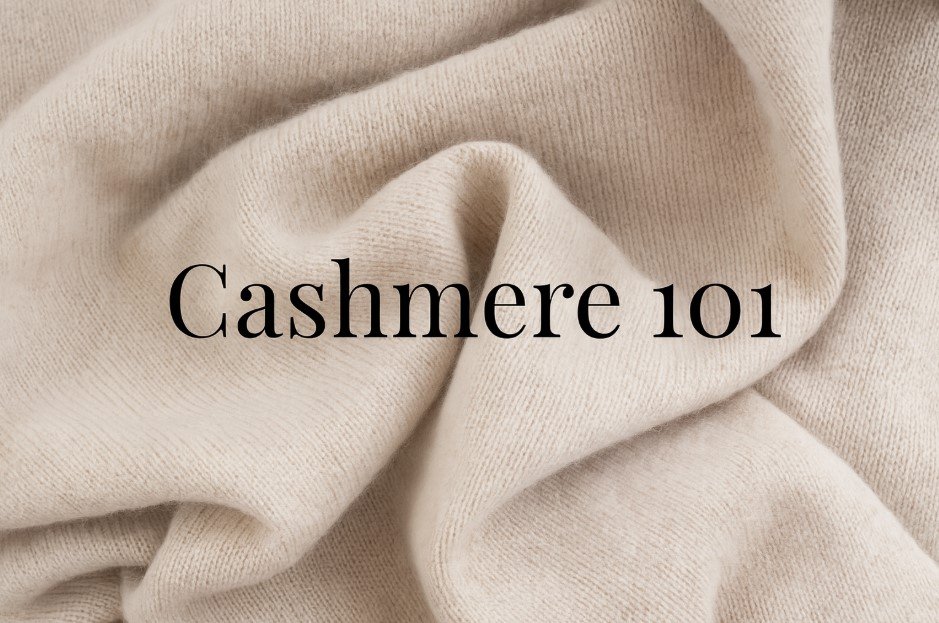Fashion
How is Cashmere Made? A Step-by-Step Guide

Cashmere is a soft and luxurious material often used in scarves, sweaters, coats, and blankets. Unlike regular wool, cashmere comes from a special kind of goat and takes more time and effort to produce. This guide explains every step in the process of making cashmere, from goat herding to finished garments. It also helps you understand its history, cost, and environmental impact.
Understanding What Cashmere is
Cashmere is a type of wool that comes from the undercoat of the Cashmere goat. These goats are mainly found in cold regions such as Mongolia, China, India, and parts of Iran. Their thick coats help them survive in harsh winter climates.
The wool used to make cashmere is extremely soft, fine, and light, which makes it comfortable to wear. It also provides excellent warmth without feeling heavy.
Many people ask what is cashmere made of. The answer is simple: cashmere is made of fine hairs from the undercoat of the goat, not the outer rough hair. These fine fibres are what give cashmere its smooth texture and insulating ability.
How is Cashmere Made?
Step 1: Rearing the Goats
The first step in making cashmere begins with raising goats in high-altitude and cold environments. These natural conditions are important because they help the goats grow their soft undercoats. The herders care for the goats year-round, feeding them properly and moving them around so they can graze on fresh pastures.
The goats naturally grow a thick winter coat starting in autumn. By spring, they begin to shed the soft underlayer, which is the cashmere fibre.

Step 2: Combing the Undercoat
Unlike shearing used in sheep, cashmere is collected through a process called combing. When spring arrives and the goats start to shed, herders gently comb the goats by hand. This method helps to remove only the fine undercoat and leaves the outer hair untouched.
The combing process takes several days for each goat. Each goat produces only around 200 grams of usable cashmere wool per year, which is why a single sweater may require fibre from multiple goats.

Step 3: Sorting the Fibres
Once the fibres are collected, they are sorted to remove impurities and coarse hair. The fine hairs are separated from the rough outer coat. This sorting is often done by hand or using simple machines.
The best quality cashmere comes from the softest and longest fibres. These high-grade fibres are what manufacturers use to make luxury clothing.
Sorting is important because it ensures that only the finest hair is used, which improves the texture and durability of the final fabric.

Step 4: Washing and Cleaning
After sorting, the cashmere fibres are washed to remove dirt, oil, and sweat. The fibres are gently soaked in water and soap, then rinsed several times. This step must be done carefully to avoid damaging the soft fibres.
The washed fibres are then dried, either under the sun or in a controlled environment. Clean, dry fibres are now ready for spinning.

Step 5: Spinning into Yarn
The clean cashmere fibres are spun into yarn. This step involves twisting the fibres together to create a continuous thread.
Spinning can be done by hand or by machine. High-end cashmere brands often use manual spinning to maintain softness and quality.
The yarn is then measured and sorted into different thickness levels. Thin yarn is used for lightweight clothing like scarves, while thicker yarn may be used for winter sweaters.

Step 6: Dyeing the Yarn
Once the yarn is ready, it is dyed in various colours. Dyes can be natural or chemical-based. Some producers prefer using natural dyes made from plants to make the process more eco-friendly.
The yarn is soaked in dye and then dried again. This step adds colour while keeping the natural texture of the cashmere soft and smooth.

Step 7: Weaving or Knitting
After dyeing, the yarn is either woven or knitted into fabric. Weaving produces tightly packed fabric while knitting creates more flexible material.
The fabric is shaped into clothing items like sweaters, scarves, and coats. The weaving or knitting process may be done by hand or using modern machines, depending on the quality level required.

Step 8: Final Washing and Finishing
The finished fabric or garment goes through one more washing process. This softens the material and removes any leftover chemicals or dirt from the dyeing and weaving stages.
Some garments may also go through a finishing process where they are stretched, brushed, or steamed. This gives them their final shape and texture before being packed and sold.
The Origin of Cashmere
The origin of cashmere goes back over a thousand years. It is believed that cashmere was first used in Kashmir, a region between India and Pakistan. The name “cashmere” itself is derived from Kashmir.
It gained popularity in Europe in the 18th century, when traders began importing it from Asia. Since then, cashmere has become a symbol of luxury and comfort worldwide.
Why Cashmere is so Expensive
Many people wonder why cashmere is so expensive. The answer lies in how it is produced. Cashmere goats yield a very small amount of fine hair each year. Collecting and processing it takes a lot of time, effort, and skill.
Each step — from combing to spinning and finishing — must be done with care to maintain the fibre’s quality. Also, the fact that it takes several goats to make a single sweater adds to the cost.
You might want to know: 10 Fascinating Facts About Mountain Goats
Cashmere Pros and Cons
Let’s take a look at the cashmere pros and cons:
Pros:
- Extremely soft and comfortable
- Provides great insulation and warmth
- Lightweight but very warm
- Long-lasting when cared for properly
Cons:
- Expensive compared to regular wool
- Requires gentle cleaning (often hand-wash or dry clean)
- Can pill or wear out if not cared for properly
Is Cashmere Durable?
A common question is: Is cashmere durable? The answer depends on how you care for it.
Cashmere is delicate but strong. When maintained correctly, a cashmere garment can last for years. Avoid using harsh detergents, and always follow care instructions. Store it properly to avoid moth damage and stretching.
What is Sustainable Cashmere?
As demand grows, so does concern about the environment. What is sustainable cashmere? It refers to cashmere that is produced with care for animals, workers, and nature.
This means:
- Ethical treatment of goats
- Fair wages for herders
- Reduced land damage from overgrazing
- Eco-friendly washing and dyeing processes
Many brands now focus on sustainable cashmere by sourcing directly from ethical farms and reducing their carbon footprint.
How to Tell if Cashmere is Real
With the rising popularity of cashmere, there are many fake or low-quality options in the market. Here are a few ways to check if the cashmere is real:
- Touch and Feel:
Real cashmere feels incredibly soft, almost buttery. If it feels scratchy or rough, it might be blended with regular wool or synthetic fibres.
- Price Check:
If the price seems too good to be true, it probably is. Real cashmere costs more due to the long production process and limited fibre supply.
- Label Information:
Always check the label. It should say 100% cashmere or pashmina (in some regions). Blends with polyester or acrylic will affect quality and comfort.

- Light Test:
Hold the fabric up to the light. Real cashmere should look slightly uneven or fuzzy due to its natural fibre texture.
- Stretch Test:
Gently stretch the fabric and then release it. Good cashmere should return to its original shape without sagging.
Grades of Cashmere: A, B, and C
Not all cashmere is the same. It is usually classified into three grades based on fibre length and thickness.
Grade A Cashmere:
- Fibre diameter: around 14-15 microns
- Fibre length: up to 36 mm
- Very soft, warm, and expensive
- Used in luxury fashion
Grade B Cashmere:
- Fibre diameter: around 16-19 microns
- Less soft than Grade A
- Still good quality but more affordable
Grade C Cashmere:
- Fibre diameter: 30 microns or more
- Coarse and less soft
- Usually blended with wool or synthetics
High-quality clothing brands often use Grade A cashmere, which feels lighter and softer than lower grades.
Common Uses of Cashmere
Cashmere is popular for making high-end garments and accessories. Here are the most common uses:
- Sweaters and Pullovers: Soft, warm, and lightweight, perfect for winter.
- Scarves and Shawls: Comfortable and stylish, used for both fashion and warmth.
- Coats and Jackets: Insulated and elegant, though expensive.
- Blankets and Throws: Often found in luxury homeware.
- Gloves and Hats: Keeps hands and heads warm without being bulky.
Cashmere is chosen not just for its warmth, but for its soft feel and minimal weight.
How to Care for Cashmere
To keep cashmere in good shape, follow these care instructions:
Washing Tips:
- Hand wash in cold water using a mild detergent or special wool soap.
- Do not wring or twist the fabric. Gently squeeze out excess water.
- Avoid washing in hot water or using bleach.
Drying Tips:
- Lay the garment flat on a clean towel and roll it up to remove water.
- Reshape it and let it air dry flat. Avoid hanging it, as it may stretch.
Storage Tips:
- Store in a cool, dry place.
- Fold it neatly instead of hanging.
- Use a sealed bag or storage box with cedar balls to protect from moths.
Pilling:
- Cashmere can develop small balls of fibre called pills.
- Remove them gently with a fabric comb or cashmere stone.
Cashmere vs. Merino Wool
Both cashmere and merino wool are known for being warm and soft, but they are different in a few ways:
| Feature | Cashmere | Merino Wool |
| Source | Cashmere goat undercoat | Merino sheep |
| Softness | Softer and more luxurious | Still soft, but not as fine |
| Warmth | Warmer for its weight | Warm but heavier |
| Cost | More expensive | More affordable |
| Durability | Less durable if not cared for | More durable |
| Use | Premium fashion items | Outdoor gear and sweaters |
Both are great materials, but cashmere is often chosen for special or luxury items.
Global Production of Cashmere
Cashmere is mainly produced in Asia. The top producers are:
- China: The largest producer of raw cashmere.
- Mongolia: Known for high-quality and ethically sourced fibres.
- India (Ladakh and Kashmir): Traditional producers of fine pashmina.
- Iran and Afghanistan: Smaller production but growing market.
- Nepal: A hub for handcrafted cashmere products.
About 6,000 tons of raw cashmere are produced globally each year. After processing, this equals around 2,000 tons of usable material — a small number considering the high global demand.
The Environmental Impact of Cashmere
Cashmere production can impact the environment, especially if done on a large scale.
Overgrazing:
Cashmere goats eat grass down to the roots, which can lead to soil damage and desertification. This is a serious problem in parts of Mongolia and China.
Climate Impact:
If goats are raised in large numbers without land management, it can affect the ecosystem.
Water and Chemicals:
Dyeing and washing processes may pollute water if not done carefully.
This is why more brands are moving toward responsible sourcing and transparency.
Supporting Ethical and Sustainable Cashmere
Consumers can play a role by choosing better options. Look for products that are labeled as what is sustainable cashmere. These labels mean the product was made with respect for animals, workers, and the environment.
What to look for:
- Certifications like The Good Cashmere Standard, GOTS, or Fair Trade
- Brands that share info about their farms and factories
- Natural dyes and eco-washing techniques
- Handmade or slow-fashion items
Conclusion
Cashmere is a luxurious material known for its warmth, softness, and light feel. It is made through a long and careful process that starts with raising goats in cold climates, collecting their soft undercoat, and turning it into high-quality garments.
Now that you know what is cashmere made of, how it’s produced, and its environmental effects, you can make better buying choices. Whether you’re buying a sweater or a scarf, look beyond just the label and consider the fibre’s origin, care needs, and ethical value.
Understanding the cashmere pros and cons, learning why cashmere is so expensive, and asking is cashmere durable before buying can help you choose garments that last longer and feel better. Also, consider what is sustainable cashmere to support ethical fashion.
From its origin of cashmere in Asia to today’s modern luxury market, cashmere continues to be one of the most valued materials in the world.
-

 Self Improvement2 months ago
Self Improvement2 months agoUsing BCBS Rehab to Access Quality Addiction Care
-

 Games2 months ago
Games2 months agoPusoy Strategies for Play That Also Work in Pusoy Dos in English
-

 Law2 months ago
Law2 months agoHow Can a Car Accident Attorney Help You?
-

 News2 months ago
News2 months agoCreating Acoustic Comfort in Restaurants: The Overlooked Ingredient of a Perfect Dining Experience






